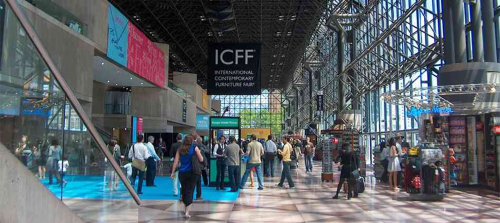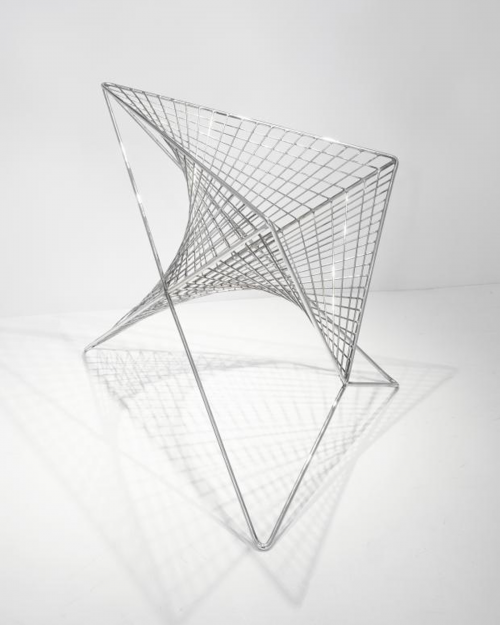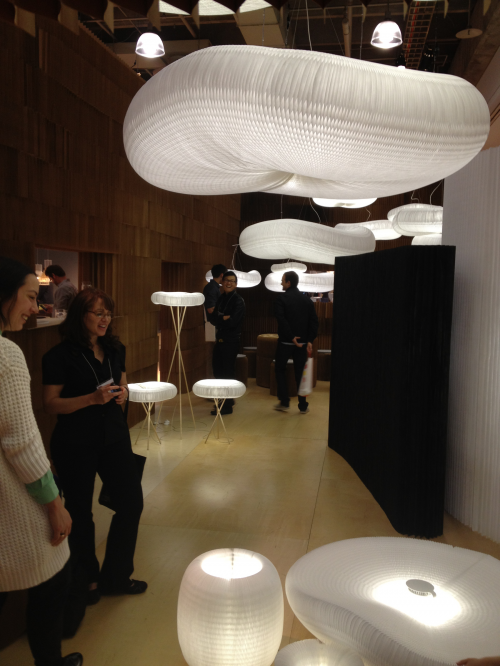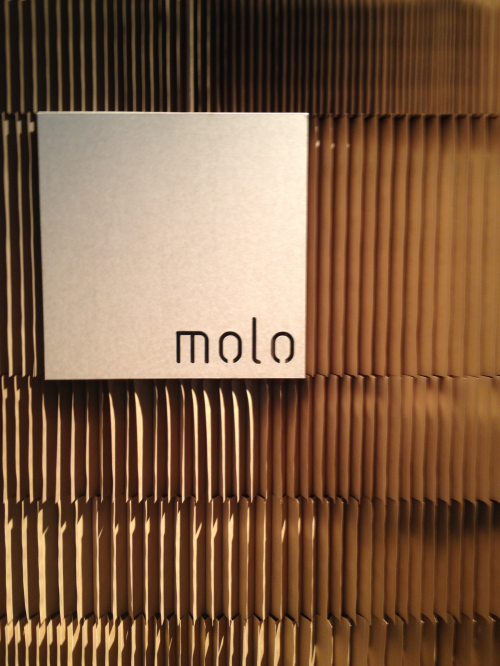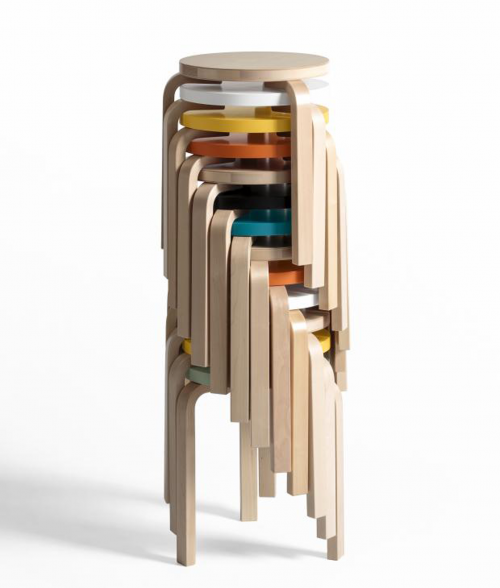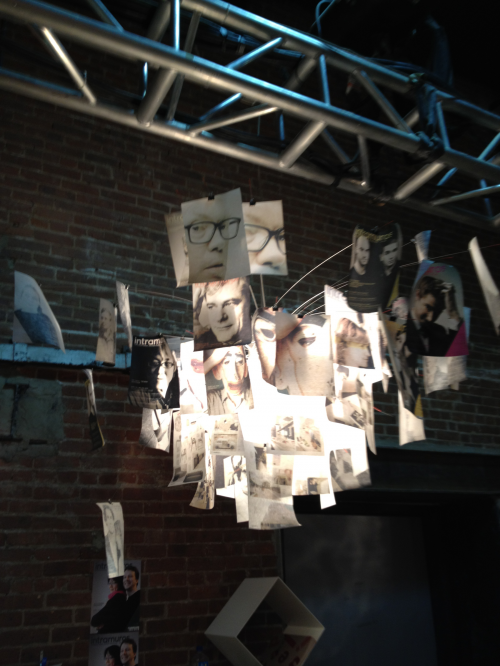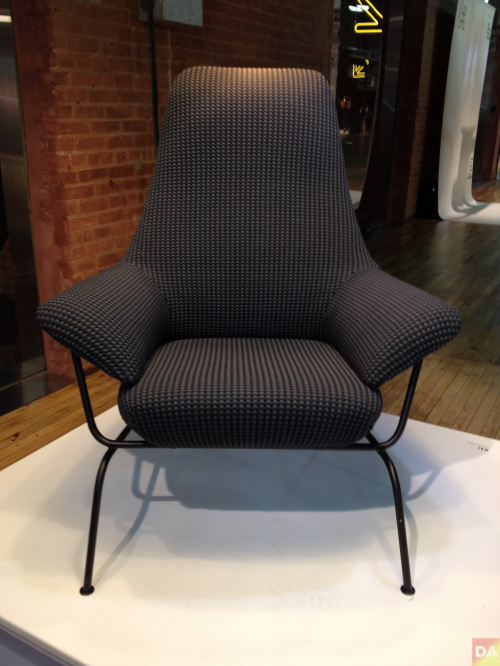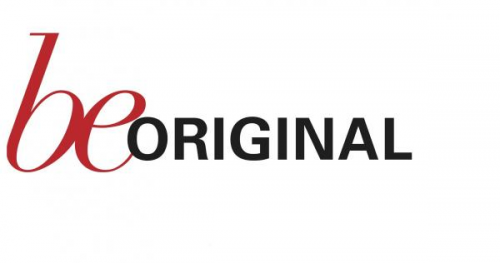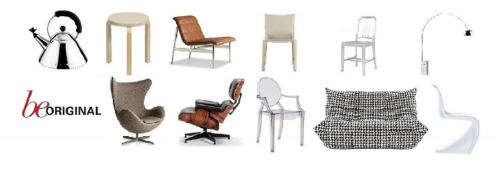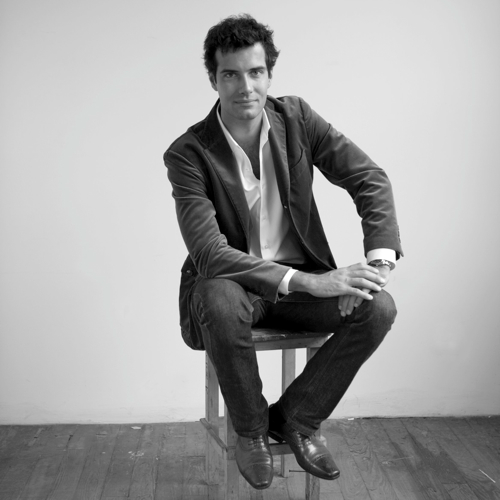
We are talking to Antoine Roset immediately following a Be Original panel discussion at [ westedge design fair ]
[DesignApplause] Please give us a little bit of an introduction to what the Be Original organization is and what its mission is.
[AR] The organization is a group of manufacturers, European and American. We decided to try to educate everyone regarding the knock off situation in the US and the origin of all these things, that’s why we are Be Original. The idea behind this is to share our know-how about the original product, and to share our passion. The concept is the more educated you are about this or that you will do the right thing. Coming to events like this is a perfect platform for our story. And thank you for taking the time to listen.
[DA] Be Original is new to me, maybe the last 6 or 8 months. Where did the idea came from, was it from one of the manufacturers?
[AR] It was Beth (Dickstein), next to me, who came up with this great idea. She’s very well connected, she knows a lot of people, a very interesting woman, and she came up with this idea one day. She called me first, and said ‘Can we sit together, can we organize everything, would you be in?’ And one day we sat, maybe like 12 or 13 people, all competitors sitting next to each other, and saying OK, yes – how can we handle this? I mean, the idea is really if not like saying it’s bad or good. It’s saying, how can we educate people about good design? And that’s how we started. This past spring it was about a year ago.
[Beth Dickstein] It was July 2012.
[AR] And slowly but surely, we created the group, we have Twitter, we have partners in the media helping us to spread the word. And we are now starting a membership. We could really use DesignApplause to spread that word.
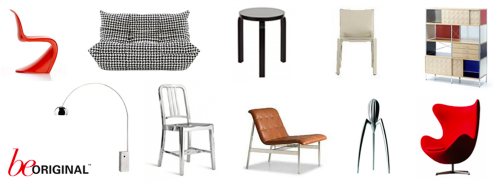
[DA] OK. Maybe it’s worth it for you to say something about the membership option.
[AR] The membership option is easy to understand. It’s free to some, like students. They can spread the word to the next generation of buyers We are creating new membership levels for 2014 Beth can explain it better.
[BD] Yes, there will be four levels of membership and you know, students certainly are free. We are trying to figure out the various levels to make sure this is supported by true believers and those who want to support the importance of original design. We should be able to post the new levels around the first of the year. And it’s really towards the marketing efforts of this. We’re all pro bono at this point. The only monies we’ve received at this point have been from the founding members. But we do need to travel to places, to have collateral materials, and other items to make sure the “grass roots” approach is spread wide!
[AR] The short movie you have seen, for example, shows our costs and we have to pay for that, so. What we are saying if you want to help the, all, original products, you can also participate by being a member of Be Original.
[DA] And the members are in fact a part of this consortium. Because obviously it goes without saying that the manufacturers who are involved are putting up a significant financial contribution to that effort as well.
[AR] Yes, exactly.
[BD] One of our first member, our paid member, was Design Within Reach. So there’s- you know, that will be very helpful for them to support us. They have a lot of locations and catalogs and things and hopefully they’re going to support us in that way as well.
[DA] And do you see the Be Original program and the whole idea of an educational initiative, do you see that as sort of auxiliary to the legal battles that we talked about or is it actually sort of an alternative road saying maybe we’d reach more people this way and saying that model of legal action isn’t working?
[AR] I will make it clear because I think it’s very important to understand: it’s a totally different approach than a legal battle. A legal battle is case by case. It’s brand by brand. And everyone is free to do whatever he wants. I’m totally free to do that. The idea of Be Original is really to have a group of people, who have a know-how, who are able to share it with people. It’s a new path to, a new way to try to explain why a knock off is not such a good thing.
[BD] There are there key ingredients to the initiative: to inform, to educate and influence.
[AR] That’s our vision.
[DA] And specifically for Ligne Roset, does that mean, are you also actively pursuing legal battles?
[AR] A minute ago, I explained it very well. For us it’s not a big part because we don’t like to walk in the past. So fighting against these people and having lawyers, big things and things like that, we’d rather put our money into new things and buy new machinery, developing new products and things like that. But yes, we fight against the lawyers.
[DA] As someone in the design community, something that I’m very aware of is that there’s a lot of people that rally around these small designers, these small independent designers, particularly in the US. There was, for example, a basket weaver named Doug Johnson earlier this year who had a small basket company. They were essentially copied, not completely knock offs, but they were copied by Target. And this was something that really rallied young designers.
[AR] I know about that and it was a major thing. And it maybe feels like a different issue to some people, to say, oh you know, these are big name manufacturers, these aren’t independent designers. So I think it’s really worth connecting how knocking off a major classic design, how it affects an established brand as well as the smaller designer. When it’s a brand, like when Ligne Roset was attacked, some are saying, ‘Oh, it’s OK, it’s a brand, you know.
[DA] Because you’re the established, how much is it really hurting?
[AR] Yes. The big brand may still be making money, that’s fine. But in the end, each product is the designer. A knock-off hits the designer whether they are working for a large company or if they’re a small independent. So it’s the same problem.
Let’s talk about us, most of our designers are between, 18 and 30. They’ve gone to school, maybe their very first products. It’s the first time they’re drawing something and giving it to a manufacturer. The media sees it and the designer is saying, ‘wow! Here we are!’ Then a year later someone is knocking off your stuff. You’re pissed off. The designers are wondering why am I in the design business. I’ve studied like for 5 years. I’m doing something, and even if I’m working with a brand, I’m being knocked off.’ So we fight. The important message here is the patent. Before you go outside, before you go public with your product, you have to protect it.
[BD] But it’s also about the designer comes to you because they know they’ll be protected. They know that nobody will be allowed to knock off their product because someone would fight for it.
[AR] Yes. Every year we have a problem. Everywhere in the world. You can’t protect all of the products. It’s way too expensive, but you’re protecting most of them. And thankfully we are doing it and I think our designers are very thankful to us for this part.
[DA] I thought an interesting point in the conversation was the idea of different entry points, different offerings for pulling people into buying and as an alternative to buying the knock off unit. Providing the instant gratification of buying, you know, the $400 sofa. Is that something that you think applies to your company, the idea of bringing in consumers at a younger age. Is that something that you’ve talked about?
[AR] We can run some promotions from time to time to help people to buy it. But creating a cheaper product, for some products it can work, for some it can’t. For example, for this one you can’t. I mean you can change the fabric, but you try to find a fabric that is cheaper, but if we do a cheaper version, a less expensive version, if you want, you’re not talking about the same product.
It’s like, take the example of Porsche. When you see Porsche you have the Carrera, the ones that everyone knows. The less expensive model is the Boxter. But a Boxter is not a Porsche.
[DA] OK. (laughing) There’s always nylon versus leather.
[AR] But it’s not the same car. Same brand, but not the same car. We can have similar products, in spirit. Less expensive, but it’s not this one exactly. You want a new shoulder bag and you don’t want a cheapest version so you wait,
[BD] But you can still buy original design that’s not expensive.
[DA] Exactly. The idea of having having those entry points and getting people in young. Getting someone like me into Ligne Roset. Sort of moving past that campaign, maybe we can just talk a little bit about what the direction of the company is right now.
[AR] For right now, the primary focus for the company is always the same, meaning that we try to develop our network, especially in the US. We develop a lot in Asia and South America. And we’d say for us it’s the usual things. We are continuing to invest more and more into the production, because we have new products coming up in January.
[DA] Within your global strategy, is there something very specific and differentiated to a North American audience?
[AR] One thing that is very specific in the US that we are developing is how fast you can have the products. We are developing a program where you purchase a collection piece in certain finishes, colors and things like that, certain products that you can purchase and you can have them within two weeks. Maximum. And this is very important for us, that we do understand the American market. We are opening more and more warehouses so that we are able to ship faster. And we hope that in the future it will be a big part of our collection. And the new program is working very well.
[DA] focusing on warehouses or focusing on web-based ordering or the the showroom and/or the store?
[AR] It’s in the store. You go in the store and they have access to stock products where they know exactly what they can have and what you can have within two weeks. So it’s a lot of logistics, so it’s as you say investing a lot in logistics and warehousing and that’s one of the focuses.
[DA] Are there any new stores that are being planned for North America, South America right now?
[AR] We are going to have a brand new store in Dallas. With a soft opening, it just opened recently, two days ago we had the soft opening. And the real opening will be within a few weeks, a month. So that’s the new one. And in Latin America we are opening in one month or two in Sao Paulo, Brazil. So that’s two.
[DA] You’ve been in the US now for how long? Can you tell us what your role is?
[AR] With my accent, you can see that I’ve been in the US for 6 months. I’ve been in the US for 7 years. That’s unfortunate, but it is true. (laughing) My job, I’m the family inn-keeper who helps the brand develop in the US. We are lucky enough to still have our family working in this company, so if you’re ready I can speak for six hours. So that’s what I’m doing for one part. And the second part is logistical. We have an office running all of North America and South America. From Edmonton to Sao Paulo, so it’s a big market. And with my team we are making sure that everyone gets the best offerings, the best marketing, everything that you need in the US because we have no manufacturers in the US. We have only offices and such. So that’s my job.
[DA] In a nutshell, and I find it’s interesting that you say in a sort of stereotypical way, and I guess correct, that the primary difference in America is that there is this feeling that you’re entitled to receiving the end product much faster.
[AR] In seven years in the US I’ve learned some things that we don’t have in Europe right now. It’s serving the clients. We are always servicing our client, but in the US you have a way to serve the client which is exceptional. And we have to always push the limits for that, so it’s a constant, if you want, working on how we can service our clients in a better way.
[DA] Another interesting new development that came up in the panel discussion is the world we live in now where people do kind of come across high-end design through purely visual means. You know, through just the image, just the Tumblr blog, just the Pinterest board. And figuring out what are the positives what are the negatives of having this snapshot visual, and ultimately you know there are negatives, that it leads to a lack of education about the product in some ways. But how do you turn it into a positive? Have you changed your marketing strategies, your social media strategies?
[AR] Two years ago, we had almost nothing. We had a website. We are super low-key because we had the website, and people were like: ‘Ooh, website.’
[DA] Because it’s the classic company, you don’t need to shout.
[AR] Yes, it’s the classic company and nobody was asking two years ago about having an iPad. And then $500, and now it’s $800 bucks for an iPad, and it’s not a computer but a tablet. So everything seems very fast, the digital especially. And in these two years, we have created a Facebook page with more than 100,000 members or fans, one of the biggest folllowings in this business. We have a Pinterest. We have an Instagram. We have a Twitter.
[DA] You have an Instagram?! (laughing)
[AR] Yes.
[DA] Alright!
[AR] I think we have almost one of everything. What am I forgetting, ah, we also have Tumblr.
[DA] You know, Tumblr and Pinterest are now the primary platform for product and it is nearly entirely visual.
[AR] Yes and very user friendly, And you have a good picture, bad picture. Most of the time, they are crap because it’s taken by your phone, it’s blurry, it just looks off. So it’s our job to put up a good picture of our product looking good, and that helps others to understand our products. We can now just say ‘I like this.’ and it’s about fun.
[DA] Great. Let’s talk a little bit more broadly about what’s happening from a design perspective. If you could sum up what you feel the design philosophy is in the office right now, what’s really exciting to you all at the moment?
[AR] It’s an easy question for us. It has always been the same, the design philosophy, the DNA of the company, is to work with designers and to create products that we like. We are lucky enough to have a company that we own, and so we can work with designers famous or not famous. Our goal is to make products with designers and to share them with everyone in a nice way.
[DA] And what are your work methods like? What are the strategies that you employ as a company to look for new talent? Because obviously, you know, you work with extremely established names like the Bouroullecs for example, but you also bring in quite a lot of, as you said, designers right out of design school.
[AR] I won’t give you strategies, because there just is really one.
[BD] Your uncle.
[AR] Yes, we are lucky enough, we have my uncle who is the head of the design, and, I don’t know if you’d say that, but he has a very good nose for design. It’s feeling. It’s relationship. You meet a designer, you have a good relationship, you’re seeing the picture, you have a good feeling about the product and things like that. So that’s how it works.
We are lucky enough we are working a lot with different programs. In France. For example, for designers who are worldwide, we are known and designers are coming to us. So that’s a good thing. On the other hand, we are doing the fairs, so we go see the young designers. But most of the time we are working with the people who are like sending us products. And we are also meeting with, it might be at a restaurant and you are talking with someone bringing a friend, ‘oh, I’m a designer,’ and you chat. And then you say, ‘Oh, you’re pretty smart, let’s see how we work.’ There are two guys, two designers, Mark and Alexander. We had been chatting about a new collaboration with Mark for three or 4 years, Alexander for a year now. It’s just relationship. And one day, I’m sure that we will work together. But it’s not like saying oh, please- I’m begging you, please do my products. No. It’s not that. WE talk, we write to see if we can work together. It’s human. It’s a human strategy.
[DA] And in terms of specific products, how important is the balance between being on sort of the trend-driven edge of the industry versus really respecting or trying to consider both material and formal, an aesthetic heritage of the company of upholstery, of foam-driven, you know, how do you strike that?
[AR] It’s a difficult balance between having a very upcoming design, sleek design, modern design, and having a more classic design and try to understand the trends in the way for production, for sustainability and everything like that. The balance arrives, we say, as we test the markets. And I don’t know, it’s more like it’s a real feeling. It’s a balance that we try to understand. We know how it works, because we have been here for more than 150 years. So we know a little bit how it works. But the balance is always shifting, depending on the country and things like that, so we have to be open-minded and be highly interactive.
[DA] Can you talk a little bit about any young designers or even specific pieces that you’re really excited about right now? That have become involved with the company in the last year or so, or things that are upcoming in the next season?
[AR] One that we just launched, a very nice lamp from Benjamin Hubert, called ‘Container By’. Beautiful. It’s ceramic.
[DA] The lamp with the colored cord?
[AR] Yes, exactly. Benjamin Hubert is a UK designer, very talented. So we are very pleased to work with him, he has very interesting products. We have done a new partnership with a good, old friend of the brand, because he has been working a lot with us. It’s Didier Gomez with a very nice sofa, more classic. We try to have worked not on the shape, on the design path, but more on the parts path. Very, very comfortable, a lot of technology of form, things like that. The sofa is Nils. That’s two products that we say we are very glad to see today, coming out, they just arrived recently in our stores.
[DA] It’s quite interesting when one talks about modern and contemporary in the same breath with products that arequite old. Your company is…
[AR] A hundred-and-fifty-three years-old.
[DA] Yes, thank you. When you talk about a heritage company and you’re calling back work from the 30s’ and the 40s’, there’s something sort of great about the fact that you’re really working on a legacy that’s much more contemporary.
[AR] It’s part of our story also. Our brands have been doing this business from 153 years ago, but with different products. We started with doing the cross part for the umbrella, the wood part. Then we did the seats for the chair in wood, OK. And then, we had two worlds. In France, it was pretty tough to us. We lost out on things. And then we have really started to work on what we do today, furniture. In the 50s’, with my grandfather, we were rebuilding France at that time, and we are working more in hospitality. And we did another shift in the 60s’-70s. Pierre Paulin, for example, we are very lucky to work with him and take back some products he has done in the 50s’ and editing them again today, all over.
[DA] Can you talk a little bit more about that?
[AR] So far we have a desk called ‘Tanis’ and this desk is from the 50s’. So it’s really designed for us, but by Pierre Paulo in the 50s’. So we have products from the 50s’ or so, we can redo, with Pierre Paulin mostly. Before he left he told us, listen, I really want you to redo this product, because I know that with Ligne Roset, I’m sure that the product will be good. In the next years, or like decades or centuries, he knows that we will take care of his products.
[DA] So we should expect to begin to see more reissues of his earlier work coming from you in the future?
[AR] We’ll decide, we’ll see.
[DA] Any other interesting new directions you wish to mention? You touched on lighting, the lamp from Benjamin. These feel like really, really contemporary and that feels like something that’s maybe a little bit new for the company, you know?
[AR] Yes, we try to add more accessories to the brand. Like with lighting, it’s an important part for us. And then doing only a little of the occasional rugs, tables, things like that so we are working more and more on that part. It’s an important development for us. And I think we’re offering more and more. I think we’ll continue to develop this part of the business.
[DA] So textiles and things like that are also maybe a part of this?
[AR] Yes, we are working more and more with suppliers of textiles. So everything is always- we try to work on everything. So sometimes we focus more on some things than something else. As for the textiles, we have been pretty good to show very nice textiles with something.
even sheets for the beds. But accessories, we try to do to give us a complete atmosphere. It’s like we can do almost everything except bathroom and kitchen. So it’s a lot.
[DA] Great, that’s wonderful. Is there anything either about the Be Original campaign, about the direction of the business that you didn’t get a chance to say that you kind of want to communicate?
[AR] It’s very good to support Be Original. I think we are going in the right direction doing this group. And it’s very important that people follow us, and continue to support original design. It’s just a heritage and people have to understand it, so support Be Original, it’s important. That’s the message of tonight.
[
be original design miami panel discussion ]
venue: dwr miami design district studio | 4141 ne second avenue | suite 101
date> 6 december 2013 | 10a > noon
[ be original ] is committed to initiating discussion on the importance and value of preserving original design across North America through informational, educational and influential marketing initiatives and consistent efforts to promote this agenda in various design contexts. Be Original founding members – including Alessi, Artek, Bernhardt Design, Cassina/Poltrona Frau/Cappellini, Emeco, Flos, Fritz Hansen, Herman Miller®, Ligne Roset and Vitra – believe that the value of authenticity cannot be underestimated or taken for granted in the marketplace. Through an aggressive program of lectures, workshops and roundtables, the movement campaigns to establish a set of industry standards that encourages consumers, the architecture and design community, producers, dealers and media partners to fully support creativity and authenticity to invest in the future of design, incentivize innovation and give back to the industry and the people it serves.
[ design within reach ] founded in 1998 and headquartered in Stamford, Conn., is the source for the best in authentic modern design. The company markets and sells its furniture and accessories to both residential and trade customers through its retail Studios in North America.








